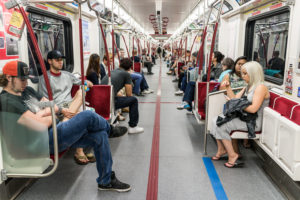
More than 50 years ago, Jane Jacobs, author of The Death and Life of American Cities, changed how a generation of urban planners and other policy-makers think about cities. Planners like me willingly bought into her proposition that density is the key to nurturing the ideas and creativity necessary to create and sustain successful cities.
Jacobs may have shone a light on the benefits of developing dense neighbourhoods, but does her credo still stand up to scrutiny? The short answer is “yes,” but there needs to be some context.
After decades spent writing plans that promote density as a tool to curb sprawl, support transit and create walkable neighbourhoods, concerns about density raised by epidemiologists and other critics are leading planners to question whether we are on the right track. In a post-COVID environment, shaped by a preoccupation to keep physically distant from our neighbours, does it make sense to continue to prescribe and invest in high density concentrations of housing and places of employment like office buildings?
No one engaged in city-building would argue that current planning and development practices are perfect. Far from it. Our preoccupation with densification has not been without cost.
In major cities like Vancouver, Toronto and Montreal, roads and transit networks strain to cope with congestion. Good quality housing is unaffordable for many. And if the current crisis has served any useful purpose, it is to highlight society’s dependence on low-paid essential workers who keep supply chains moving and stock the shelves in grocery stores but don’t necessarily reap the benefits of living in large cities.
Will density opponents use COVID as an excuse to undermine plans for densification?
Concerns about the impact of COVID on public support for density first emerged in New York City, the North American epicentre for the virus. At the height of the crisis there, New York State Governor Andrew Cuomo tweeted: “There is a density level in NYC that is destructive…NYC must develop an immediate plan to reduce density.”
This is not life as usual.
There is a density level in NYC that is destructive.
It has to stop and it has to stop now.
NYC must develop an immediate plan to reduce density.#StayAtHome
— Andrew Cuomo (@NYGovCuomo) March 22, 2020
The New York Times then proclaimed, “density is New York City’s big ‘enemy’ in the coronavirus fight,” quoting epidemiologist Dr. Steven Goodman as saying “Dense cities are petri dishes that spread the coronavirus.” This prompted Michael Kimmelman, the Times’ architectural critic, to warn that “opponents of density will seize on COVID-19 to undermine support for projects that depend on density.”
Concerns about density should not be confused with the problem of overcrowding, however. A city’s development policies can mandate upper limits for the scale of buildings, but market forces too often overwhelm the best laid plans. When low-income families are forced to double up or share accommodations, this makes it impossible for people to keep their distance.
University of British Columbia professor Patrick Condon, commenting on New York’s epidemic, noted that “the incidence of community spread is higher in New York’s lower density suburbs, which just happen to be home to many poorly paid essential workers, than in central Manhattan.” The same is true in downtown Vancouver and Toronto, he added, where condo residents are more likely to “afford the luxury of working from home.”
This perspective is shared by Toronto consultant Ken Greenberg. Speaking with the Daily Commercial News, he argued in favour of “bringing public health experts to the urban design table… to offer a fresh perspective on neighbourhood design features that promote physical and mental well-being. The solution is not density at any cost, but density done right.”
Public support for density – fragile at the best of times – erodes when residents perceive that new housing projects are simply too large for the neighbourhood. This can happen when cities allow developers extra density in return for setting aside a percentage of units for social or affordable housing purposes.
An alternative approach, for which I advocated as a member of Toronto’s external advisory committee on housing last year, but which is well suited to a post-COVID environment, is for cities to stop selling off publicly owned surplus property for whatever the market will bear. Creating long-term leases with developers, instead of selling, establishes mutually beneficial partnerships.
These deals generate cash flow for the municipality, allow projects to be developed at more reasonable densities and, importantly, promote the notion that a municipality’s priority is for carefully considered planning decisions that benefit the neighbourhood.

Is working from home the new normal?
The other side of the density coin affects office buildings, which combine the ability to achieve high employee density in individual office towers with the bigger idea of concentrating office buildings in clusters.
The downtowns of Vancouver, Toronto and Montreal are highly dependent on such clusters. Concentrations of downtown offices – the product of a convenient marriage between planning policy and market necessity – provide transit systems with fare-paying commuters that in turn sustain the vibrant economic ecosystems of shops, cafés, restaurants and street life, which are a trademark of big cities. The closure of all non-essential businesses in March triggered by the COVID-19 pandemic caused an immediate negative impact on both fronts.
In the Greater Toronto Area, more than half of all jobs are office jobs. In Toronto’s Financial District, the sudden requirement to work from home affected more than 400,000 commuters, 65 percent of whom typically enter downtown on transit.
The Toronto Transit Commission (TTC), which carries the bulk of these commuters, has suffered a decline in ridership of 85 percent and is projecting losses of more than $500 million by Labour Day if current conditions persist. The city is appealing for help from the provincial and the federal governments to cover this catastrophic loss.
Collateral damage from COVID is not confined to transit operators. In cities everywhere, landlords, employers and commercial real estate brokers are wondering out loud whether the dramatic shift to remote working will affect the need for – and future value of – office space. Working from home – or “telecommuting” as it was known in the 1970s, when enabling technology first emerged – is suddenly being practiced on a grand scale.
Daniel Holmes, managing director of the office practice group at Colliers Real Estate, says that before COVID, Canadians had been slow to embrace the concept of working from home but this is rapidly changing. “This (response to COVID) serves as a catalyst for workplace transformation, as companies … rapidly learn and adopt new practices and perspectives on where and how employees can work,” he told the industry newsletter BizNow. “The office of tomorrow is here, and you’d better get used to it.”
Some companies have already made up their minds. Waterloo-based Open Text, with 15,000 employees around the world, recently announced that productivity benefits inspired by the sudden switch to remote working have led the company to plan a reduction of the company’s office space footprint by up to 50 percent.
For Iain Dobson, a former commercial real estate executive with whom I co-founded the non-profit think tank Strategic Regional Research Alliance in 2013 to help policy-makers make better decisions about investments in public transit, this announcement is not a surprise. “The Open Text office environment lends itself to working independently at home,” Dobson told me. “This is also not the first time that office employees have been faced with predictions that their working world is about to be disrupted. Companies like Xerox in the 1980s, IBM in the 1990s and Compaq after 2000 all conducted experiments in working from home for mostly cost-cutting reasons. These initiatives were not sustained over the long term. The amount of personal space per worker has been on the decline for over 50 years; COVID, and the requirement to keep physically distant, may reverse that.”
But the reality is that working from home is not a viable option for many workers. Only those with the luxury of space at home and the freedom to work without interruption can realistically choose that option. The trend of apartment/condo living is on the rise, which means that competition for workspace at home will be at a premium for many in the years ahead.
The urge to abandon high-priced, centrally located commercial real estate may be attractive to executives looking to cut costs. A recent article in The Economist quotes several UK bankers keen on the idea. But many high profile academics like Richard Florida, who heads the Martin Prosperity Institute at the Rotman School of Management at the University of Toronto, question whether ubiquitous video conferencing technology and networking apps will prove to be an effective substitute for personal interaction and face-to-face communication over the long term.
The immediate challenge facing government and business leaders alike, however, is how to re-open cities safely and cost-effectively. The dilemma facing Toronto is that Ontario’s economy depends heavily on what takes place in the Financial District. Many commuters simply do not have an alternative to transit. To get the Financial District – and many similar clusters of offices in cities across the country – up and running again, employees returning to work must be confident that both their office environment and their journey to work, be it on the subway, streetcar or bus, is safe.
Although landlords and transit operators are taking innovative steps forward to deal with logistical and hygienic challenges, the basic geometry of transit vehicles must also be addressed.
Providing for physical distancing means that transit vehicles will need to carry fewer passengers. So, in Toronto, the TTC and its provincial commuter counterpart GO Transit, must be given the financial room to maintain or even increase service levels in the coming months. In the short-term it may also be necessary to stagger the workday in shifts, following a precedent set in New York in the 1990s. Although the motivation back then was to compensate for sky high office rents by effectively reducing the cost of office space per employee, commuters briefly enjoyed less crowded commutes. The same concept could be applied in Toronto and other high-density office concentrations.
The COVID crisis can be a turning point
The COVID-19 pandemic has turned the world upside down, fostering what Greg Clark, founder of the UK company The Business of Cities, warns is a “return of anti-city sentiment, with fears of contagion resulting from human interactions on public transport, in gathering places, and in compact and dense real estate, leading to renewed prophecies of the unbundling of the city, the death of geography.”
The crisis imposed by COVID represents an opportunity not to change course but to re-set priorities. At this point, although no one knows exactly when or how cities will return to something that resembles normalcy, the ensuing uncertainty is affecting everyone from housing advocates to major employers and transit operators – all the more reason that urban planners, policy-makers and others who believe in the role of density in driving successful cities should make their voices heard.
This article is part of the The Coronavirus Pandemic: Canada’s Response special feature.







